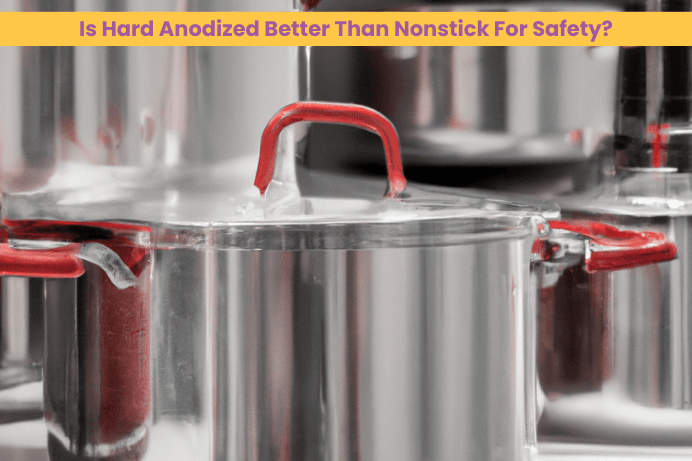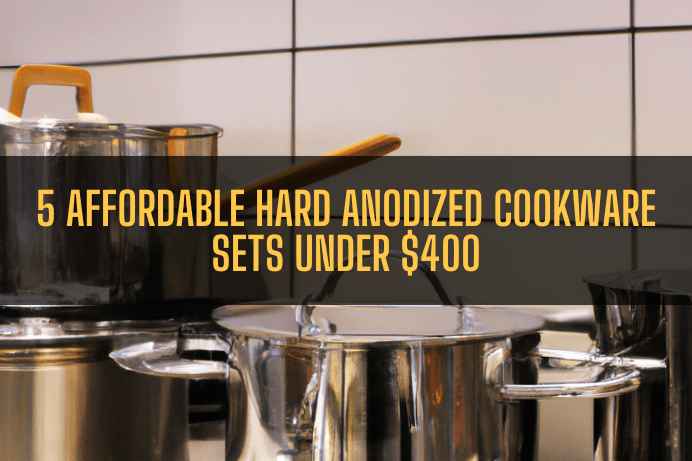Is Hard Anodized Better Than Nonstick For Safety? The Safety Concerns You Should Know For Healthy Cooking
Are you tired of worrying about the safety of your cookware every time you whip up a meal?
Look no further! We’ve got the inside scoop on whether hard anodized or nonstick cookware is safer. Hard anodized cookware is built to last and can withstand even the most challenging cooking situations, but does that mean it’s safer than nonstick cookware?
Hard-anodized aluminum cookware shares similar advantages with nonstick pans but is more durable and scratch-resistant. It ensures your pots and pans remain undamaged even with daily use.
Nonstick cookware is known for its effortless food release, but concerns have been raised about the potential health risks associated with the coating.
So, which one is the winner in the safety department? Keep reading to find out!
Comparison of the Safety and Durability of Nonstick vs. Hard Anodized Cookware
Nonstick and hard anodized cookware are two popular types, each with unique characteristics. Here are some of the factors that apart nonstick to hard anodized cookware:
Surface Coating Of Nonstick Vs. Hard Anodized Cookware
The main difference is the coating on the cookware’s surface. Nonstick cookware is typically coated with a layer of polytetrafluoroethylene (PTFE), also known as Teflon. This coating allows food to slide easily off the pan’s surface, making it an ideal choice for cooking delicate foods like eggs and pancakes. However, concerns have been raised about the potential health risks associated with PTFE, as it can release toxic fumes when heated to high temperatures.
On the other hand, hard anodized cookware is made by treating aluminum with an electrochemical process that hardens the surface of the metal. This process creates a durable, scratch-resistant surface that can withstand high temperatures without a nonstick coating. Hard anodized cookware is also non-reactive, so it won’t interact with acidic foods, like tomatoes or citrus, and change the dish’s flavor.
Maintenance Of Nonstick Vs. Hard Anodized Cookware
In terms of maintenance, nonstick cookware requires gentle care to avoid damaging the delicate coating. In contrast, you can wash hard anodized cookware in the dishwasher, which is generally more durable.
Which Is Safer For Cooking: Hard-Anodized Or Nonstick Cookware?
While nonstick cookware is known for its easy food release, it may pose potential health risks, while hard anodized cookware is durable and non-reactive, making it a safer and more versatile option.
Here, we’ll explore the characteristics, benefits, and safety aspects of nonstick vs. hard anodized and help you decide which one is better suited for your needs.
Understanding Hard-Anodized Cookware
Hard-anodized cookware is made by immersing aluminum in an acid bath and exposing it to electrical currents. This process creates a hard, non-porous surface resistant to scratches and abrasion. The anodization process seals the aluminum, preventing any leaching into food and making it non-reactive.
The Benefits of Hard-Anodized Cookware
One of the main benefits of hard-anodized cookware is its durability. The anodized coating is hard and scratch-resistant, making it less likely to wear or chip over time. You can use it for years without worrying about replacing it. Another benefit is that it can withstand high temperatures, making it ideal for searing and frying foods.
Understanding Nonstick Cookware
Nonstick cookware has a coating that prevents food from sticking to its surface. This coating is usually made of polytetrafluoroethylene (PTFE) or Teflon. PTFE is a synthetic polymer that has been in use since the 1940s. It is a popular choice for nonstick cookware due to its low friction and resistance to high temperatures.
The Benefits of Nonstick Cookware
The primary benefit of nonstick cookware is its nonstick surface. It does cooking and cleaning much easier, as food slides off the surface without sticking. It can also reduce the amount of oil or butter needed in cooking, making it a healthier option. Additionally, nonstick cookware is relatively lightweight, making it easy to handle.
Safety Concerns of Nonstick Cookware
While nonstick cookware has many benefits, there are some concerns regarding its safety. The PTFE coating can release toxic fumes when heated to high temperatures, harming humans and pets. Additionally, the coating can wear off over time and leach into food, which may cause health issues.
So Which one Stand Out Among Nonstick And Hard Anodized Cookware?
Hard-anodized cookware stands out due to its durability and scratch-resistant properties. It can withstand high temperatures and is less likely to chip or wear over time. Additionally, hard-anodized cookware is a non-reactive material, ensuring it won’t interact with acidic foods and alter the taste of your food. Overall, hard-anodized cookware is safer and more reliable for your kitchen.
Is nonstick cookware harmful to health?
Regarding nonstick health risks, it’s widely accepted that modern nonstick cookware is safe. According to the American Cancer Society, new PFOA-free nonstick cookware poses no known risks to human health.
Is scratched anodized cookware safe?
If you’re concerned about the safety of scratched hard anodized cookware, the good news is that it’s generally considered safe to use. Unlike nonstick cookware, which can release harmful chemicals when scratched, hard anodized cookware has no nonstick coating that can peel off. However, avoiding using metal utensils and abrasive sponges on your cookware is still a good idea to prevent scratches and extend its lifespan.
Which one is better? Hard anodized or nonstick?
When it comes to choosing between hard anodized and nonstick cookware, it depends on your cooking needs and preferences. Nonstick cookware is great for easy food release and hard anodized cookware is more durable and scratch-resistant.
Additionally, hard anodized aluminum is generally considered safe for cooking, as it doesn’t react with acidic foods and won’t leach harmful chemicals into your meals. Overall, both options have pros and cons, so it’s essential to consider what’s most important to you before deciding.
What are the hard anodized cookware health risks?
When it comes to hard anodized cookware, minimal health risks are associated with its use. The anodizing process creates a hard, non-reactive surface resistant to scratches, corrosion, and wear. It means hard anodized cookware is less likely to leach harmful chemicals into your food, even when cooking with acidic ingredients. However, avoiding using metal utensils and abrasive sponges on your cookware is essential to prevent scratching, as this can affect its non-reactive properties over time.
Is hard anodized cookware safe to use?
The safety of hard anodized cookware is a common concern for many people. The good news is that high-grade anodized aluminum cookware is perfectly safe for cooking. The hard coating on the surface of the cookware acts as a protective layer, preventing any leaching of harmful chemicals into your food.
Is hard anodized cookware reactive?
After the question of whether hard anodized cookware is safe, the next concern is whether it is reactive. The answer is no, as hard anodized cookware undergoes an electrochemical process that creates a thick layer that acts as a protective barrier between the food and the aluminum layer. This non-reactive layer allows cooking with various ingredients, including acidic ones like tomato sauce and soy sauce, without altering the taste. However, it’s important to note that essential aluminum cookware is reactive and should be avoided.
Conclusion
When it comes to safety, hard-anodized cookware is the better option. It is a non-reactive material, which means it won’t interact with acidic foods and alter the taste of your food. Additionally, it doesn’t release any toxic fumes, even at high temperatures. On the other hand, nonstick cookware may pose some health risks due to the potential release of toxic fumes and the wearing off of the coating over time.
In summary, both hard-anodized and nonstick cookware have their advantages and disadvantages. However, regarding safety, hard-anodized cookware is the better option. It is durable, scratch-resistant, and non-reactive, making it a healthier and safer choice for your kitchen.





